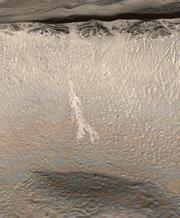 This gully has grown in the past few years.NASA/JPL/MSSS
This gully has grown in the past few years.NASA/JPL/MSSSPhotographs snapped of Mars show gullies that must have grown sometime in the past seven years. That, researchers say, is strong evidence that liquid water is still flowing on the red planet today. And with running water comes a better chance of finding life.
Previous work had suggested that some gullies on the planet are new in geological terms. But that could have meant anything from millions of years ago to just yesterday. The latest data, collected by the orbiting Mars Global Surveyor (MGS) before its recent demise (see 'Goodbye Mars Global Surveyor'), suggest that water flows are happening now.
"Recognizing new contemporary processes is always a thrill," says Michael Malin of instrumentation company Malin Space Science Systems in San Diego, California, who led the investigation. "The current gully activity was anticipated, but to find it actually happening was very cool."
Scientists are a long way from finding any evidence of little green bacteria on Mars, but now, they say, they have a better idea where to look. "If I were looking for life on Mars, I'd bias my research in the direction of these features," says Mike Ravine, one of Malin's colleagues.
The same project has also revealed some 20 craters that have formed since 2004. An accidental snap with MGS's wide-angled camera in January 2006 caught a black smudge of the dust kicked up by an impact. Earlier high-resolution images of this area showed no crater — in later snaps there was a small one.
Getting data about how often craters form on the surface will help scientists to date other features on Mars by looking at the cratering there. "Knowing how old bits of the surface of Mars are helps us know what Mars did when," says Albert Haldemann, Mars exploration rover scientist at the Jet Propulsion Laboratory in Pasadena, California.
Ice caps
Mars was known to hold water — but in the form of ice. There are polar ice caps on the planet, and radar signals have hinted at underground ice.
The MGS pictures, analysed by Malin and his colleagues, show gullies that look very much like they have been formed by flowing liquid — they have finger-shaped branches and travel around obstacles just as a stream on Earth would do; and there are sedimentary deposits at the ends of the tracks.
One of the gullies was snapped first in 2001, and then again in 2005. During that time, about 300 metres of new deposits had been formed. In another gully, formed sometime between 1999 and 2004 in a crater in the Centauri Montes region, a number of finger-shaped branches appeared over an area of about 600 metres.
"It really is showing we're probably getting liquid water under current climate conditions," says Nathan Bridges, who works on the High Resolution Imaging Science Experiment (HiRise), which is flying onboard the Mars Reconnaissance Orbiter.
Though there are other features on the Martian surface that seem to have been produced by flowing water — deltas at the ends of river valleys and vast flood plains — they are far, far older than the gullies seem to be.
Salty flow
There is no definite explanation yet for how the gullies are forming, or where the water might be coming from.
The gullies could be formed from snow deposits, but Malin is betting on underground water sources. His guess is that water is being heated deep within the planet's crust and bursting out to form the gullies. The question remains how the water manages to stay liquid on the chilly surface of the planet, which averages temperatures of well below zero.
ADVERTISEMENT
"It is possible, but we don't yet have evidence, that freezing point depressants are in solution," says Malin. Salt water, for example, freezes at a lower temperature than fresh, and martian water is expected to be very briny. Pockets of the surface might also trap a lot of sunlight, heating up a small area.
These things cannot be figured out from pictures. Landing on the planet and taking samples would be the best way to work out once and for all what is happening
HiRise will set up a sort of gully watch — it has already spotted some gullies in a region very near to one of Malin's finds, and there are plans to take pictures of these every few weeks.
Visit our couldbeflowingon_mars.html">newsblog to read and post comments about this story.
